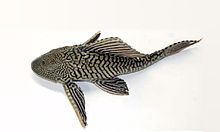
Ancistrus is a genus of nocturnal freshwater fish in the family Loricariidae of order Siluriformes, native to freshwater habitats in South America and Panama. Fish of this genus are common in the aquarium trade where they are known as bushynose or bristlenose catfish. In the aquarium hobby they are often referred to as bushynose or bristlenose plecos instead, but this may lead to confusion as "pleco" usually is used for Hypostomus plecostomus and its allies and is often used as a catchall term for any loricariids remotely resembling that species.

Hypostomus plecostomus, also known as the suckermouth catfish or the common pleco, is a tropical freshwater fish belonging to the armored catfish family (Loricariidae), named for the longitudinal rows of armor-like scutes that cover the upper parts of the head and body. Although the name Hypostomus plecostomus is often used to refer to common plecostomus sold in aquarium shops, most are actually members of other genera.

Loricariidae is the largest family of catfish, with 92 genera and just over 680 species. Loricariids originate from freshwater habitats of Costa Rica, Panama, and tropical and subtropical South America. These fish are noted for the bony plates covering their bodies and their suckermouths. Several genera are sold as "plecos", notably the suckermouth catfish, Hypostomus plecostomus, and are popular as aquarium fish.

Hypostomus is a genus of catfish in the family Loricariidae. They are native to tropical and subtropical South America. H. plecostomus is the popular freshwater aquarium fish formerly known as Plecostomus plecostomus. The taxonomic structure of the Loricariidae is still being expanded by scientists. Hypostomus is a highly species-rich and widely distributed catfish genus.

Plecostomus, pleco, or plec is the common name of several species of freshwater loricariid catfish commonly sold as aquarium fish.

The genus Panaque contains a small number of small to medium-sized South American suckermouth armoured catfishes that are notable for being among the very few vertebrates that feed extensively on wood. In addition, algae and aufwuchs are an important part of the diet, and they use their rasping teeth to scrape this from rocks. These fish are also popular aquarium fish, where the sound of scraping as these fish forage for food is easily audible.

Pseudorinelepis genibarbis is a species of armored catfish native to Brazil, Peru, and Ecuador where it is found in the Amazon basin.
Sailfin catfish, Janitor fish can refer to any of:

Acanthicus is a genus of large, South American suckermouth armored catfishes native to the Amazon and Orinoco basins, and possibly in Guyana. The name Acanthicus is derived from the Greek, akanthikos meaning thorny, spiny. Fish of this genus are known as lyre-tail plecos. These species are found in large rivers, primarily in areas with a rocky bottom and a moderate or strong current.

Pterygoplichthys gibbiceps is a species of armored catfish native to Brazil, Ecuador, Peru and Venezuela where it is found in the Orinoco and Amazon basins.

Peckoltia is a genus of small South American armored suckermouth catfishes. Many of these fish are popular aquarium fish.

Hemiancistrus is a genus of suckermouth armored catfishes. These species are native to South America. The taxonomy of this genus is complex and unclear, and major work has to be done. Many of these fish are popular aquarium fish.

Rhinelepini is a tribe of fishes in the subfamily Hypostominae of the armored suckermouth catfish family Loricariidae.

Ancistrini is a tribe of catfishes of the family Loricariidae. Most are restricted to tropical and subtropical South America, but there are also several genus in southern Central America.

Pterygoplichthyini is a tribe of catfishes of the family Loricariidae. It includes two genera, Pterygoplichthys and the currently undescribed genus referred to as the Hemiancistrus annectens group, This group was earlier misspelled as Pterygoplichthini. Pterygoplichthyines are known from nearly the entire range of loricariids except for the Guyanas and coastal streams in southeastern Brazil. although later work by the same authority, and his co-authors, placed this group among the genus Hypostomus.

Pterygoplichthys multiradiatus is one of several tropical fish commonly known as Orinoco sailfin catfish, plecostomus. It belongs to the armored catfish family (Loricariidae). Named for its sail-like dorsal fin, the part of its scientific name multiradiatus means "many-rayed" and refers to the rays of the dorsal fin. P. multiradiatus is one of a number of species commonly referred to as the common pleco by aquarists.

Pterygoplichthys pardalis, the Amazon sailfin catfish, is a freshwater tropical fish in the armored catfish family (Loricariidae). It is one of a number of species commonly referred to as the common pleco or "leopard pleco" by aquarists.It can be called 豹紋翼甲鯰 in Mandarin Chinese.
Pterygoplichthys ambrosettii, sometimes known as the snow king pleco, is a species of armored catfish native to south-central South America.
Pterygoplichthys anisitsi also known as the Paraná sailfin catfish, southern sailfin catfish, is a species of catfish in the family Loricariidae. Its natural range is the middle Paraná and Uruguay River basins of south-central South America, but it has been introduced to North America and South Asia, probably via the pet trade. Like other loricariid catfishes, Pterygoplichthys anisitsi has a ventral mouth modified into a sucking disk and a body covered in bony plates. The species typically has a dark and white spotted body pattern, although some individuals are very dark with few spots. It reaches 55 cm in total length and can weigh up to at least 2.3 kg.
Pterygoplichthys weberi is a species of catfish in the family Loricariidae. It is native to South America, where it occurs in the basins of the Amazon River, the Japurá River, the Marañón River, and the Ucayali River in Colombia, Ecuador, and Peru. The species reaches 19.7 cm in standard length and is known to be a facultative air-breather.















